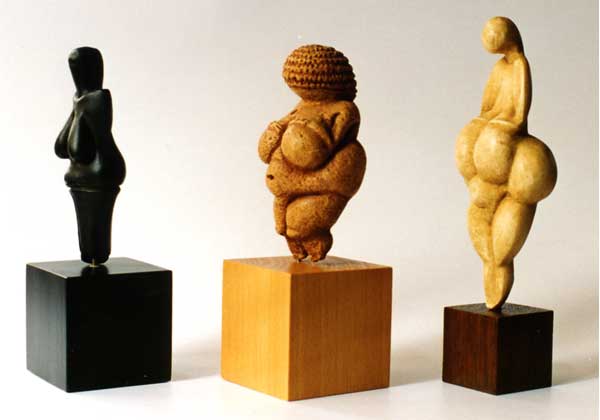Since the early stages of human life and prosperity, art has used by different societies to display their craftsmanship and to demonstrate their beliefs. Two types of artistic creations are the paleolithic Venus figurines from southern France and the bronze age jade figurines of China. These two art pieces contrast in both usage and symbolism. The figurines in the paleolithic, European era were made by hunters and gatherers, while jade figurines during the Bronze Age are part of an advanced civilization. Still, both provide scholars insight into the practices and goals of the people at the time.

One of the earliest forms of art includes the figurines from the European paleolithic era. Created by homo sapiens about thirty thousand years ago, they were called Venus figurines by scholars after the Roman goddess of love Venus, because they depict the body of a woman. Today, more than one hundred have been found and they all have similar characteristics. The figurines range in height but are on average 150mm tall. They are made from materials such as steatite, calcite, limestone, bone, ivory, and clay.1
Today we wonder about the meaning and purpose behind the faintness of facial features and hands in these figurines, yet we note the emphasis on the woman’s hips and legs. Although we do not yet have definite answers to this question, there are many theories available. One popular theory is that the societies that created these figurines had a deep interest in female fertility. Other theories mention their hope for survival and fear for extinction.2 A less popular and more controversial theory is the possibility that Venus figurines were self portraits.3 Still, different theories are necessary in order to better comprehend the motifs behind the Venus figurines and their crafters.

In contrast to the Venus figurines in Europe, Chinese jade figurines offer a clearer sense of the usage of art in the Bronze Age. Jade figurines were often buried with wealthy individuals along with their former slaves, food, jewels, and many other objects. Although the jade figurines took very long to make and were a process of hard labor, their symbolism of prosperity and luxury in Chinese ceremonial traditions demonstrate the practice of ancestral worship and how important it was to them. Because they believed spirits passed into another realm of existence, from which they had the power to affect future generations, tombs were lavished with tools so that masters might live plentifully along with sacrificed slave bodies that would continue to serve their master. For example, in the tomb of lady Fu Hao, wife of the Shang king Wu Ding, 755 jade carvings, 468 bronze objects, 130 weapons, and 4 mirrors were buried.4
Although prehistoric pieces such as figurines, cave paintings, and carvings are often overlooked because of the ambiguity of their meaning, they convey people’s emotions, ideas, and talents. Creations such as the Venus and jade figurines provide the world insight into the practices of our ancestors and the kinds of resource available to them. They serve as a timeline and teach us about their interests and abilities in eras as diverse as the European Paleolithic and Chinese Bronze Ages.
- Kaylea Vandewettering, “Upper Paleolithic Venus Figurines and Interpretations of Prehistoric Gender Representations,” PURE Insights 4, no. 1 (May 29, 2015), http://digitalcommons.wou.edu/pure/vol4/iss1/7. ↵
- Jerry H. Bentley, Herbert F. Ziegler, Traditions and Encounters: A Global Perspective on the Past Volume 1: From the Beginning to 1500 (New York, NY: McGraw-Hill, 2011), 14. ↵
- Kaylea Vandewettering, “Upper Paleolithic Venus Figurines and Interpretations of Prehistoric Gender Representations,” PURE Insights 4, no. 1 (May 29, 2015), http://digitalcommons.wou.edu/pure/vol4/iss1/7. ↵
- Jerry H. Bentley, Herbert F. Ziegler, Traditions and Encounters: A Global Perspective on the Past Volume 1: From the Beginning to 1500 (New York, NY: McGraw-Hill, 2011), 92-93. ↵



61 comments
Hector Garcia
Overall, I thought that this article was quite fascinating because it shows the audience figurines from past civilizations. I also found the comparison between the clay figurines in Europe and the Jade figurines in Asia quite interesting. Throughout history, artifacts were created and have survived for thousands of years and today, they serve as a timeline. I believe that the author did a great job in portraying how important these figurines were to past civilizations.
Anna Guaderrama
I learned a lot from reading this article. For one, I’ve never thought about the different materials used in the creations of these figurines. I still don’t even know what steatite is but it’s shocking to learn that bone is mentioned, and in extent clay because when I think of clay I don’t exactly think about it as the most durable material for figurines that would still be intact to this day.
Kimberly Simmons
I never knew about these figurines; it’s weird that their meaning has not yet been uncovered. It surprises me that they were not further looked into considering their artful craftsmanship – they are very well done for such an early time period. I wonder what else they were potentially used for; if I had to guess, I’d say either decoration or in burials.
Natalia Flores
I enjoy how the writer talked about the similarities between different statues and stressed their connection to the goddess Venus. These statues have always struck me as more as a looking glass into their society since these statues placed emphasis on fertility. It also amazes me how they focus on the legs and hips of women which I never noticed before.
Auroara-Juhl Nikkels
Art is such an individual thing, in the terms that people see all art differently. It’s up to you to interpret it, but it still brings people together. Your article was very well written and there was many details about the art figurines. Art is a way of looking into the past. We do not just learn about the events that happenee, but also the views that people had and the way that the people of the time viewed society.
Natalie Childs
I loved this article. I think that art is a great way to see what the people that came before us valued and this article showed that we are able to get glimpses of the past from what is left behind. Also, I really like the examples that were chosen for this article: the statues of Venus and the jade figurines. While they are so different, I completely agree with the author when she says that they “convey people’s emotions, ideas, and talents” and that is why they are so important.
Caroline Bush
Interesting article! I really enjoyed the amount of detail that you put into this article. We talked about the figurines from The Bronze Age in class so this was a interesting way to get more information about them. Its really fascinating how there were different theory’s as to the Venus figuring’s meaning behind its facial features and body proportions. overall this was a very interesting article that I really enjoyed reading.
Natalia Carroll-Long
I love how you explain the importance of figurines in art. I agree as well because not all art is on a flat surface. I find it very interesting how although China and Europe are two different places, but are both creating these figurines. It kind of makes this world feel smaller than it really is. In addition to Europe and China – correct me if I’m wrong – but weren’t there people in Africa who also made figurines that they took everywhere they went because of the power it symbolized?
Hanadi Sonouper
The freedom of art expression is multi cultural phenomenon, which endeavors humans abilities to push the creative envelope in new ways. The idea of figurines is an interesting choice, the article does a great job at highlighting the major aspects as to where the initial idea surfaced. Having been used by our ancestors to symbolize many things, one of them being the body depiction of a woman symbolizes imperfections and beauty that each individual should be proud of. Each figure is not meant to be the same, the creativity aspect comes from the utilization of how each homo sapien differs from one another, the height, shape and structure all come in to play to create a unique master piece. The author does a wonderful job to tie in the routes of Chinese and European heritages to introduce an aspect as to how those specific cultures utilize this art form. All in all, it was a fantastic article that showcases an art form that many do not know too much about, and it is refreshing to hear from a new perspective.
Cherice Leach
Art is very important and necessary to understand the days we were not yet born. This article is suer interesting and you do a great job describing the different figurines that were made in ancient times. I think the Venus figurine is interesting and my theory is that she was a beautiful goddess that everyone admired and obeyed so they mad figurines of her so she would live on forever. Quite different from the thoughts about women back then but it’s a pretty good theory if you ask me.